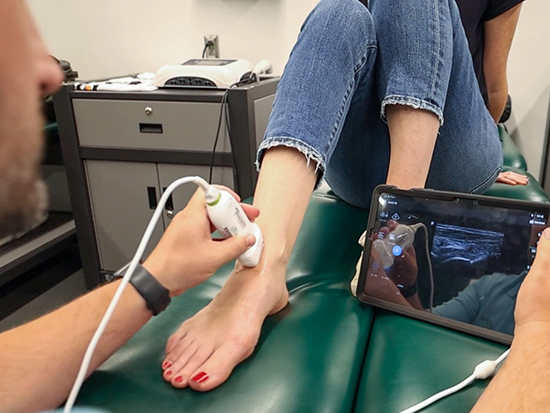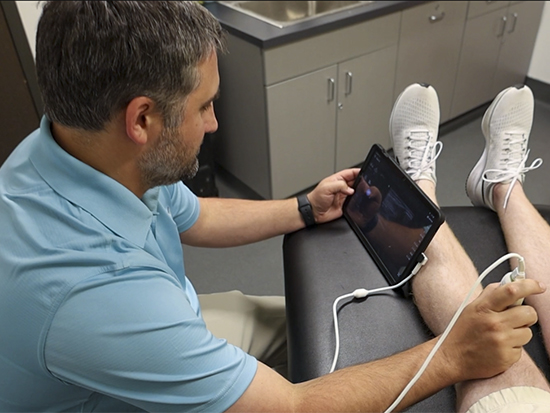by Caroline Newman, Katherine Mozzone and Matt Windsor
 A pocket-sized point-of-care ultrasound (POCUS) device, connected to a tablet or phone, allows physicians to get answers quickly and potentially save patients a referral or extra trip to another facility.For most people outside of health care, ultrasound is synonymous with babies. But the same technology that makes gender-reveal parties possible can do much more.
A pocket-sized point-of-care ultrasound (POCUS) device, connected to a tablet or phone, allows physicians to get answers quickly and potentially save patients a referral or extra trip to another facility.For most people outside of health care, ultrasound is synonymous with babies. But the same technology that makes gender-reveal parties possible can do much more.
Clinicians at UAB are using handheld ultrasound machines, known as point-of-care ultrasound, or POCUS, to identify soft-tissue infections, fluid accumulation in the joints and abdomen, gallbladder disease, kidney stones, heart failure, dehydration, and more.
POCUS is making its presence felt on playing fields as well. “Our Sports Medicine team uses POCUS to help evaluate musculoskeletal injuries, including fractures, muscle strains and ligament sprains,” said Steven Brown, M.D., assistant professor in the Department of Family and Community Medicine. “POCUS can also be used to evaluate for catastrophic internal injury,” such as the lacerated liver that sidelined star football player Travis Hunter of the University of Colorado in September 2023.
Meet the “stethoscope of the future”
Unlike the dedicated machine on wheels wielded by technicians in labor and delivery units or hospitals, a POCUS unit is meant to fit in a clinician’s pocket and connect to a tablet or smartphone to visualize the results. “Clinicians can use handheld ultrasound to evaluate almost every major organ system and better visualize suspected pathology,” Brown said. Some have even called it the “stethoscope of the future.”
That is why, this fall semester, every student in the Heersink School of Medicine will have access to a POCUS unit — the Butterfly IQ device. This POCUS Initiative is funded by $2 million in federal grant money awarded to the Department of Family and Community Medicine.
“UAB is one of the only medical schools in the United States that will offer an integrated, longitudinal POCUS curriculum with an emphasis on promoting primary care and improving the care of the medically underserved,” Brown said. In addition to the 600 devices for medical students, the POCUS Initiative includes 100 units for the community preceptors who teach UAB medical students in their clinics. The department will educate and train residents and faculty, as well as medical students, Brown adds.
Committed to serving in rural and urban underserved areas
The Department of Family and Community Medicine’s Comprehensive Urban Underserved and Rural Experience program, or CU2RE, makes the POCUS Initiative possible. CU2RE was created through a $7 million grant from the federal Health Resources and Services Administration in 2020 to recruit, train and retain medical students interested in primary care and committed to serving in rural and urban underserved areas of Alabama. The goal is to mitigate the projected shortfall of 600 primary care providers in Alabama by 2030.
 Steven Brown, M.D., assistant professor in the Department of Family and Community Medicine (at left, demonstrating use of a POCUS unit), says that in addition to training medical students, the department will educate and train residents and faculty as well.POCUS could be particularly helpful in caring for patients in rural and urban underserved areas, who already face significant wait times for appointments or must travel long distances for medical care, explains Irfan Asif, M.D., chair of the Department of Family and Community Medicine, associate dean for Primary Care and Rural Health at the Heersink School of Medicine and director of UAB’s primary care service line.
Steven Brown, M.D., assistant professor in the Department of Family and Community Medicine (at left, demonstrating use of a POCUS unit), says that in addition to training medical students, the department will educate and train residents and faculty as well.POCUS could be particularly helpful in caring for patients in rural and urban underserved areas, who already face significant wait times for appointments or must travel long distances for medical care, explains Irfan Asif, M.D., chair of the Department of Family and Community Medicine, associate dean for Primary Care and Rural Health at the Heersink School of Medicine and director of UAB’s primary care service line.
What can a primary care doctor do with handheld ultrasound?
With handheld ultrasound, a health care provider could determine “whether a soft-tissue lesion is an abscess or a cyst or a lipoma or a mass,” each of which would require different treatment decisions and follow-up tests, said Erin DeLaney, M.D., vice chair for Clinical Care and Quality of UAB Family and Community Medicine – Highlands. POCUS could let a doctor know “whether someone has a torn tendon, look at the gallbladder for stones or look at the heart to determine how well it is functioning,” DeLaney said. “With handheld ultrasound, you can do all of these things instead of sending your patient out for additional tests or referrals.”
Brown offers two more examples. Leg pain in a patient could be the result of any number of causes. One particularly concerning cause would be a blood clot in a leg vein, known as deep vein thrombosis, that could break loose and get stuck in the lungs. “Primary care providers being able to assess for deep-vein thrombosis could prevent the need for a long drive to the closest ER for evaluation,” Brown said. “Another example would be evaluation of the shoulder for a rotator cuff tear — that may prevent the need for ordering an MRI.”
“The future of medicine, especially primary care in rural and underserved areas, will require physicians to be nimble, meet patients where they are and find efficient ways to address a wide variety of concerns right there in clinic,” Asif said. “Point-of-care ultrasound offers a great way to do that, especially in rural areas with less access to major hospital systems or other points of care.”
